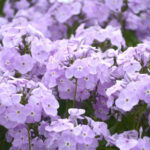
Written by Dr. Bob Lyons
Let’s face it, there are plenty of choices for your garden, especially when it comes to herbaceous perennials. Do they fit your design scheme or do you just want them and you’ll worry about the design later? It can be a pleasantly daunting challenge to decide which perennials make it onto your “spring planting” short list. Well, to help you out, phlox is the perennial highlight in the 2023 UDBG Plant Sale and there will be many to choose from.
The UDBG phlox selection may generally be divided into one of four large groups, all of which are native to the northeastern region of North America. These four species have lots of overlapping common names, like creeping phlox, moss phlox, spreading phlox, woodland phlox, and summer phlox. They’re all descriptive enough but don’t indicate specific or unique features. Because these names can lead to confusion, we’ll use the botanical names, instead. Also, when searching for a plant in the sale, you will find the botanical name used on the labels but not to worry, there are lots of volunteers who can help you at the sale!
Gardeners choose specific phlox varieties for many reasons, often making flowering time and duration a priority. The earliest phlox will bloom before deciduous trees have even leafed out or just starting to do so. Phlox stolonifera and P. divaricata species, and their various selections, behave as such; with P. subulata types flowering a bit later in spring. Flowering duration is harder to predict with certainty. While flowering may last for weeks, unusually warm temperatures will speed up the process and shorten display time. These three species are popular with gardeners who are anxious for an early start, looking for early color, especially where shade is prevalent. In fact, these species are well-suited for woodland gardens. P. subulata varieties, however, grow best in full sun or a mix of both sun and shade. All three of these species can create a spreading, massive spring display and will be real head-turners in full bloom. The fourth member of this grouping, P. paniculata, will flower much later, usually in mid to late summer, lasting many weeks when the weather is cooler. Full sun will also lead to superior floral displays, which appear as larger heads with many individual flowers. This species and its selections have a clumping, not spreading, habit, which means they will not only extend the aesthetic season for phlox in the garden, but also stay in place. A classic perennial border is the perfect place for P. paniculata varieties, especially because their heights range from the shortest at about 1.5 feet tall, to over 3 feet. Couple these differences with a plethora of flower colors, and it would be hard to believe there isn’t a phlox for everyone.
Speaking of color, most choices are found within P. paniculata with a range of white, pink, red, purple, bicolor and star patterns of contrasting colors. Make sure you read the label and/or catalog descriptions carefully so you won’t be disappointed. It is safe to say that selections and hybrids derived from P. paniculata clearly reflect its long-lasting and sizable popularity among gardeners over time. On the other hand, the early spring bloomers have the most restrictive color palette. The colors white, purple, and shades of blue characterize P. subulata, P. divaricata, and P. stolonifera flowers. The ground-covering nature of these three species produces a stunning and massive visual impact once mature…completely different from the clump-forming habit of P. paniculata.
Historically, varieties of P. paniculata were plagued by powdery mildew. Foliage would become blemished and necrotic, and flowering was impaired over time. Thankfully, however, with the introduction of the cultivar ‘David’ over 20 years ago, powdery mildew is becoming much less problematic as newer, resistant varieties come to market. The UDBG sale will feature several resistant varieties, including ‘Jeana’ and ‘Fashionably Early Flamingo’.
So, are you looking to bolster your native plant presence? Diversify your existing gardens? Or simply join the bandwagon of long time perennial enthusiasts who have been growing phlox for decades? If so, then the UDBG plant sale should be your destination!



